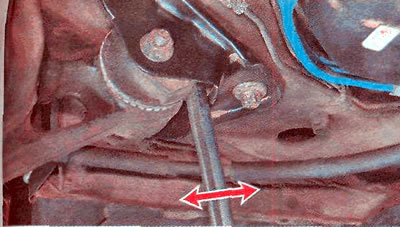You can assess the technical condition of the suspension while the car is moving. When driving at low speed on uneven roads, the suspension should work without knocks, squeaks and other extraneous sounds. After driving over an obstacle, the vehicle must not sway.
Recommendation. Suspension checks are best combined with checking the condition of tires and wheel bearings (see «Rims, tires and hubs - checking the technical condition»). One-sided wear of the tire tread indicates deformation of the rear suspension parts.
To perform the work, an inspection ditch or overpass is required.
Execution sequence
1. We prepare the car for work (see «Preparing the car for maintenance and repair»).
Recommendation. It is necessary to check the performance of the shock absorbers immediately after a long trip, while the working fluid in the shock absorbers has not cooled down.
1. Vigorously swing the back of the car body in a vertical direction. If, due to inertia, the body continues to oscillate (more than two: up and down), after they stopped swinging it, it means that one or both shock absorbers are faulty. To identify a faulty shock absorber, we repeat the test, applying efforts first from one and then from the other side of the car.
Comment. Such a check allows you to identify only faulty shock absorbers. It is possible to check the effectiveness of vibration damping by shock absorbers only on a special stand.
3. We inspect the suspension shock absorbers - leakage of fluid from the shock absorbers is not allowed.
4. Using the mount as a lever, we check the integrity of the silent blocks of the rear suspension. If there is noticeable play, the rear suspension beam must be replaced.

5. We check the tightening of the nuts for fastening the suspension parts, if necessary, tighten them with torques (see «Reference data»).
6. We examine the details of the suspension. Deformation and fatigue cracks in suspension parts are not allowed. We replace damaged parts.

Visitor comments